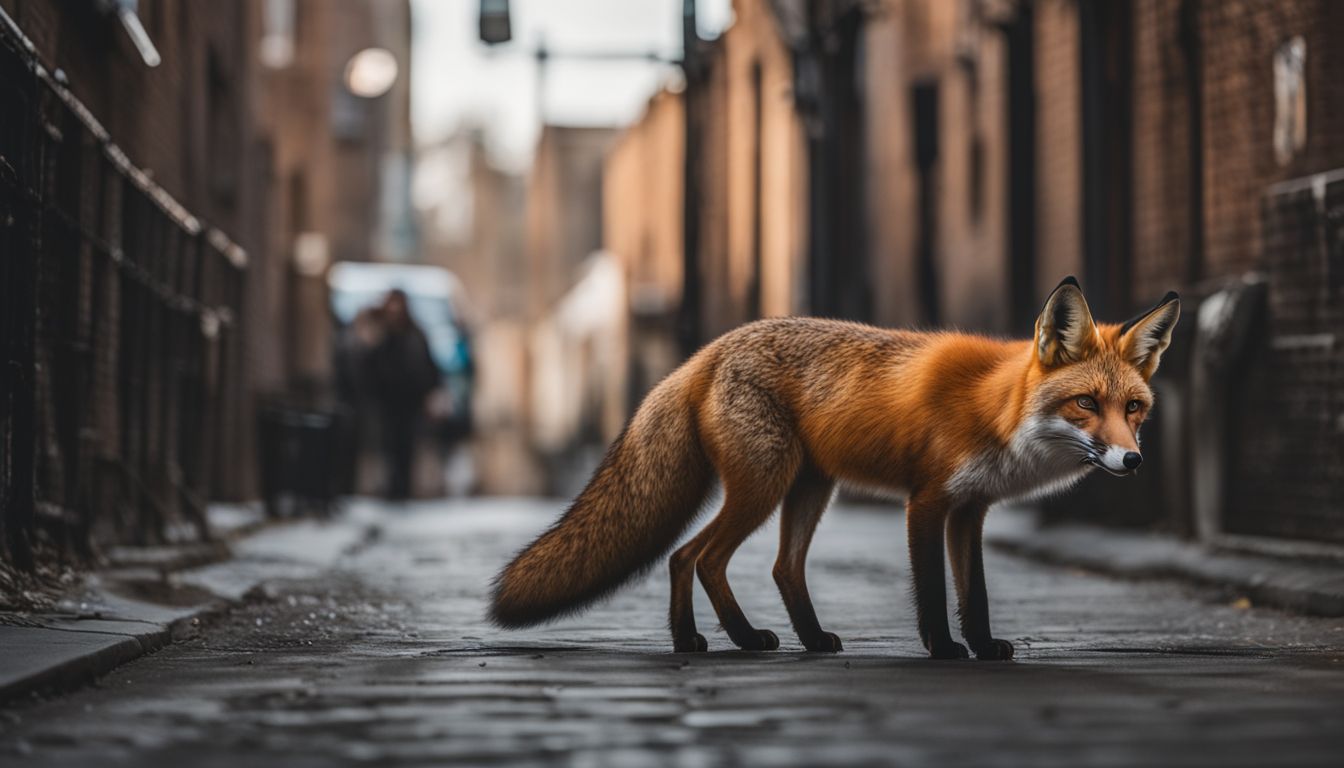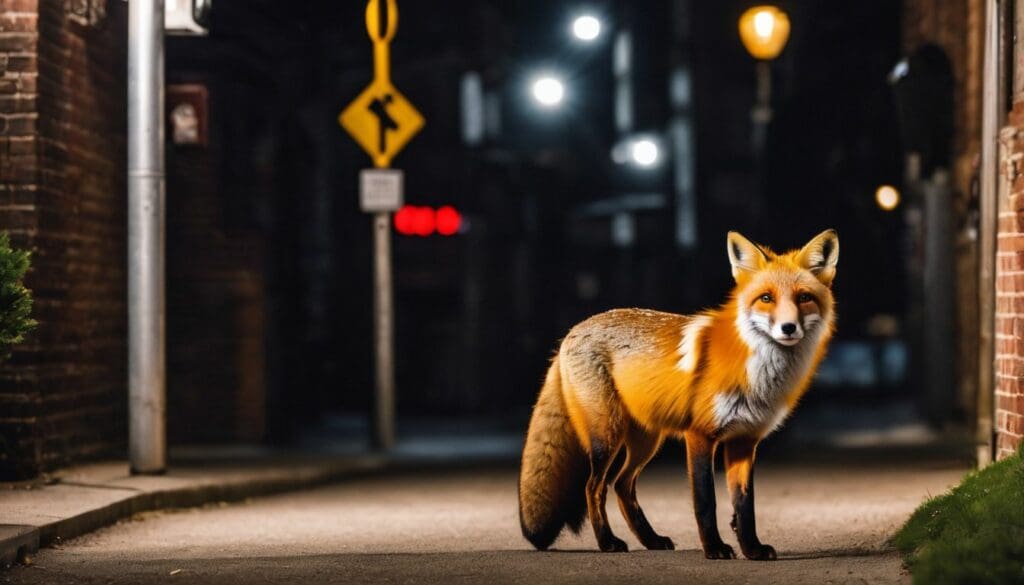Many of us have had the rather charming experience of spotting foxes as they deftly navigate our city streets. It’s a sight that is as beguiling as it is bewildering, stirring curiosity about how these creatures manage to thrive amidst the urban sprawl.
You’re likely pondering this very question right now. In today’s post, we shall delve into the world of red foxes (Vulpes vulpes) and discover just how these cunning animals are flourishing on our very doorsteps.
Their ability to adapt to the concrete jungle is nothing short of remarkable. Do stay tuned as we explore their secrets together!
Key Takeaways
- Urban foxes have evolved anatomical features like smaller heads and wider snouts to forage effectively in cities, eating a variety of foods including leftovers from humans.
- They contribute positively to urban ecosystems by controlling rodent populations and scavenging waste, thus playing a part in city sanitation.
- Red foxes (Vulpes vulpes) face challenges such as diseases, parasites, and dangers from traffic. We can help them through conservation efforts like creating green corridors and responsible waste disposal.
- Fox social dynamics are changing due to increased population density within urban spaces; they’re learning to live closer together than they would naturally.
- The future success of urban foxes depends on our ability to coexist peacefully with them. Education about their behaviour is key for human-fox relations to thrive in city environments.
Historical Overview: How Did Foxes Come to Our Cities?

Foxes first crept into our urban landscapes on their dainty paws, in search of a bite to eat and a cosy nook to call home, deftly navigating the concrete jungle that sprawled across their old countryside haunts.
As towns mushroomed and the rolling hills became patchworks of green amid grey, these cunning creatures espied an opportunity amidst the plethora of resources our cities unwittingly proffered.
They commenced their shift to city life decades ago, lured by the prospect of easy pickings from our discarded leftovers and facing less rivalry than within their natural wild domains.
We clock their presence in brief glimpses; russet fur dancing against stone or an abrupt yap that slices through the cloak of night – tokens of a transformative epoch in urban ecology unfolding before us.
Their advent heralds a palpable transformation not exclusively for local habitats but equally for our own perceptions of wildlife co-existing with us in our bustling boroughs. Now let’s cast a closer look at how anatomical adaptations have poised them to prosper amongst bricks and clamour.
Anatomical Adaptations of Urban Foxes

In the bustling heart of city life, urban foxes flaunt subtle yet fascinating changes in their anatomy–a tale of evolution right on our doorsteps. These sly creatures showcase smaller heads and broader snouts, a testament to their knack for scavenging in our concrete jungles.
Smaller Heads and Wider Snouts
We’ve observed fascinating changes in urban foxes, adapting their anatomy to city living. One striking change is the development of smaller heads and wider snouts compared to their rural counterparts.
This shift may give them an edge when rummaging through narrow spaces and foraging for food in our cluttered urban landscapes. Their broader snouts also help them hunt different prey than what they’d find in the wilds beyond city limits.
Their scent marking abilities are put to use more efficiently with these adaptations, allowing them to communicate and establish territories within the concrete jungle. These physical changes show how urban foxes have become adept at exploiting new resources, altering their approaches as they navigate human-dominated environments.
Up next, we’ll delve into how this has affected their foraging behaviour.
Changes in Foraging Behaviour
Foxes prowling city streets have turned over a new leaf in their search for food. Gone are the days of reliance on natural prey alone; urban foxes now raid bins and prowl gardens to feast on leftovers.
They’ve become nocturnal scavengers, adapting their diets to include whatever scraps our cities provide. This shift reflects their intelligence and ability to thrive in ever-changing environments.
City life demands slyness from these clever canids, and they’ve mastered the art of silent stalking among alleyways and back lots. From discarded apple cores to fast-food throwaways, urban foxes find nourishment in what we leave behind.
Their adaptable nature plays a vital role in waste management within our urban ecosystems, revealing just how intertwined our lives have become with theirs.
Behavioural Adaptations of Urban Foxes
Urban foxes display remarkable behavioural adaptability, mastering the concrete jungle as deftly as their rural counterparts navigate woodland. They’ve refined their habits and routines to thrive amid the city’s bustle, demonstrating a fascinating flexibility that belies their wild nature.
Alterations in Diet
We’ve noticed that urban foxes have shifted what they eat to thrive amidst concrete jungles. They feast on a menu vastly different from their rural cousins, munching on leftovers discarded by humans, and snatching up rodents that flourish in city alleys.
Their opportunistic feasting habits show just how adaptable these creatures are; they’re not picky eaters and will often go for the easiest meal available – whether it’s a dropped kebab or fruits from backyard trees.
These foxes demonstrate incredible versatility by diversifying their diet, so they don’t rely solely on any single food source. This change means they can make the most of the resources cities inadvertently provide.
Foxes zigzag through our streets at night, scavenging through bins and taking advantage of urban offerings whilst avoiding competing with each other too fiercely for traditional prey like birds.
Altered Sleeping and Hunting Patterns
In cities, urban foxes shift their sleeping and hunting to avoid the hustle of human activity. They nap in secluded spots during the day and come alive at night, when our streets are quieter.
This nocturnal lifestyle allows them to forage through bins and gardens without much disturbance. Their keen senses help them navigate the urban jungle, finding food that ranges from leftovers to small mammals.
Foxes adjust their hunting tactics in response to city life. Stealth becomes their ally as they stalk prey amidst concrete rather than underbrush. These clever animals have learned that patience pays off in an environment where food sources are unpredictable but often plentiful after dark.
By staying alert and adapting quickly, these survivors make the most of what the urban environment has to offer.
The Impact of Urban Environment on Foxes’ Lifestyle
In the hustle of our concrete jungles, urban foxes have nimbly adapted their lifestyles. The relentless sprawl of city life shapes every aspect of their existence, from cunning changes in their social dynamics to the very spaces they dare call home.
Increased Population Density
Cities are growing and so is the number of foxes sharing our urban spaces. As we expand into their natural habitats, foxes have no choice but to adapt to living closer together than they ever would in the wild.
This increased population density influences their behaviours tremendously. They must navigate a maze of gardens, alleys, and human constructions while establishing territories and social hierarchies within tighter confines.
Our presence has transformed their survival strategies. Foxes now exhibit changes in foraging behaviour as they exploit new food sources provided by our waste. We see them rummaging through bins and even boldly snatching leftovers from busy streets during the night.
Their adaptive skills show remarkable flexibility, but this proximity brings challenges both for them and wildlife conservation efforts aiming to balance urban development with the needs of native species like red foxes (Vulpes vulpes).
Changes in Territory and Habitat
We’ve observed foxes adapting their territories within the ever-expanding urban sprawl. As natural habitats shrink, these clever canids are carving out new living spaces in our suburbs and cities.
They’re becoming a familiar sight, navigating neatly between buildings and over fences with ease that speaks to their incredible adaptability.
Our towns offer a patchwork of opportunities for foxes to set up home. They take advantage of parks, abandoned lots, and even quiet corners of gardens to establish dens. These changes aren’t just about finding space; they’re reshaping the very structure of fox social hierarchy.
Close quarters lead to more encounters with fellow foxes and alter longstanding pecking orders as resources like food become concentrated in human-dominated landscapes.
Foxes and Human Interaction
In our bustling cities, we’ve become neighbours with urban foxes, leading to a variety of encounters. These interactions can range from endearing sightings to more concerning moments, raising questions about cohabitation and the balance between human activity and wildlife presence in our shared spaces.
Potential Risks to Humans
We must acknowledge that urban foxes can pose certain risks to humans, although these cases are rare. Foxes may carry diseases such as rabies and the less commonly known myxomatosis, which primarily affects rabbits but if transmitted could potentially impact pets in urban areas.
Their search for food can lead them into conflict with people, especially when they rummage through garbage or come too close to human dwellings. This behaviour sometimes results in foxes becoming more daring and less fearful of humans.
Our gardens and properties might also attract foxes, creating an uneasy coexistence. They dig up lawns searching for grubs or establish dens under sheds, which while fascinating from a wildlife perspective, can be troublesome for homeowners.
It’s essential we stay informed about how to peacefully coexist with these adaptable creatures as part of our shared environmental responsibility within the ecosystem where both humans and urban wildlife manage to thrive alongside each other.
Benefits to the Urban Ecosystem
Urban foxes bring unexpected advantages to our cities. Their presence helps control rodent populations, which in turn reduces the spread of disease and protects food supplies in urban areas.
These cunning animals also contribute to biodiversity, supporting a dynamic balance within the ecosystem by occupying a unique niche as both predators and scavengers.
Their nightly foraging behaviors can even assist in keeping our streets cleaner by consuming discarded waste. Not only that, but observing foxes can enhance community engagement with local wildlife, fostering a sense of stewardship for nature right on our doorsteps.
Turning towards how these streetwise creatures interact with us reveals another layer to their role in city life.
The Role of Foxes in Urban Ecosystems
In our bustling cityscapes, foxes play a crucial part in maintaining ecological balance, orchestrating the complex interplay of predator and prey. They’re not just survivors but active participants in urban waste management, subtly shaping the environment we share with them.
Predator and Prey Dynamics
In the bustling urban landscapes, foxes play a crucial role in maintaining the delicate balance between predators and prey. They hunt rodents and small birds, keeping these populations in check.
This natural form of wildlife management prevents overpopulation of certain species, which could lead to increased disease spread and crop damage. Their presence creates a dynamic environment where survival strategies must evolve quickly.
Foxes’ predatory instincts also influence their scavenging habits. They often clean up food waste left by humans, reducing the likelihood of attracting other pests into our neighborhoods.
It’s fascinating how they’ve adapted to exploit both natural resources and human leftovers for survival. With their keen olfactory signals, they navigate complex urban terrains to find their next meal – be it a hidden rodent or discarded takeout.
Moving forward from understanding these dynamics within city limits, it is just as important to consider how urban foxes interact with another key part of their ecosystem – us humans.
Scavenging and Waste Management
As we consider the role of foxes in controlling prey populations, let’s shift our focus to their contribution to urban sanitation. Foxes are opportunistic feeders and excel in scavenging, which beautifully complements waste management efforts.
They rummage through bins and clean up discarded food that might otherwise attract pests like rats.
Their nightly forays serve a dual purpose—they keep our streets cleaner and maintain their survival amidst the hustle of city life. By embracing this often overlooked aspect of their behavior, we’re acknowledging foxes as unsung heroes in our urban ecosystems.
Their innate habit helps curb overflow in landfills, proving that even in cities, nature has its own efficient way of managing resources.
Challenges Faced by Urban Foxes
Urban foxes navigate a maze of threats, from disease to onrushing traffic, in their daily struggle for survival. Our streets pose relentless tests to these adaptable creatures, with the clash between nature and urbanisation creating an ever-evolving battleground.
Disease and Parasites
We often overlook the challenges urban foxes face when it comes to diseases and parasites. These hardy animals are battling a variety of illnesses that can spread quickly through dense populations.
For instance, red foxes (Vulpes vulpes) may suffer from sarcoptic mange—a skin condition caused by mites—severely affecting their health. Other contagious diseases like the myxoma virus pose serious threats, not only to individual foxes but also potentially to domestic pets.
Foxes also contend with internal parasites such as worms, which can be detrimental to their well-being. Keeping an eye on our bushy-tailed neighbours helps us understand these issues better and reinforces why conservation efforts are so pivotal.
Let’s now shift our attention to how ongoing urban development affects these adept survivors – another critical facet of their secret lives in the city.
Dangers from Traffic and Human Encounters
Moving beyond the illnesses that can plague these agile creatures, we must consider their perilous dance with urban life. Foxes navigate a landscape full of fast-moving vehicles, and sadly, collisions are not uncommon.
These incidents often result in severe injuries or death for the foxes, disrupting local populations and leaving behind tragic reminders of the delicate balance between wildlife and city living.
Foxes also face challenges from direct human encounters. While fox sightings can delight us, not all interactions are positive. Instances of aggression may occur if a fox feels cornered or threatened by humans or pets.
Moreover, some people unknowingly lure them closer with food offerings, leading to dependency issues and potential conflict. It’s our collective responsibility to safeguard these animals by being mindful of our actions and giving them the space they need to thrive amidst our urban sprawl.
Comparisons with Other Urban Wildlife
In exploring the tapestry of city life, urban foxes share the stage with other adaptable creatures like coyotes. We observe fascinating parallels and unique strategies as each species carves out a niche in our concrete jungles.
Similarities and Differences with Urban Coyotes
As we delve into the lives of urban foxes, it’s fascinating to draw parallels and distinguish the differences between them and another adept city dweller, the urban coyote. Here’s a concise comparison in table form:
| Aspect | Urban Foxes | Urban Coyotes |
|---|---|---|
| Size | Generally smaller than coyotes | Larger, more robust build |
| Habitat Flexibility | Highly adaptable to various city environments | Prefer urban fringes but can adapt to inner-city life |
| Diet | Opportunistic feeders, diets consist largely of scavenged waste and small rodents | Similar opportunistic feeding habits but may hunt larger prey |
| Social Structure | Tend to be solitary or live in small family groups | Often form larger packs, which can be more complex socially |
| Nocturnal Behavior | Primarily nocturnal, especially in heavily populated areas | Also nocturnal, but may be seen during the day, particularly in less disturbed areas |
| Interaction with Humans | Generally avoid humans but have become more habituated in urban settings | Increasingly habituated to humans, can sometimes lead to bold behavior |
| Risks | Face threats from traffic, human confrontation, and domestic pets | Similar risks, but also susceptible to persecution due to their size and perceived threat |
| Role in Ecosystem | Control rodent populations, aid in seed dispersion | Control larger pests and can impact populations of medium-sized mammals |
| Conservation Concerns | Less controversial, often viewed positively in urban settings | Can become contentious, especially when they pose a threat to pets or livestock |
We observe that urban foxes and coyotes share adeptness in navigating city landscapes, yet their physical attributes, social structures, and roles within the urban ecosystem present a study in contrasts.
The Future of Foxes in Urban Environments
As we contemplate the continuing saga of urban foxes, it’s clear that their resilience will be tested by the evolving landscape of our cities. The strategies they will adopt and the role they’ll play in metropolitan ecosystems present a dynamic chapter yet to unfold, shaping both their survival and our understanding of wildlife adaptation in urban settings.
Predictions and Possibilities
We can almost hear the soft pitter-patter of fox paws on city pavements as we envision their future alongside us. Urbanisation’s relentless sprawl suggests red foxes (Vulpes vulpes) will continue to adapt in surprising ways.
They might develop even more nuanced behaviours to navigate the maze of streets and human activity. Picture fox families marking out territories with scent markings, claiming pockets of greenness amid concrete jungles.
Their role within urban ecosystems could become pivotal; imagine them maintaining a balance by keeping rodent populations in check or aiding waste management through scavenging. We may discover new aspects of behavioural ecology, like changes in their social structures or novel examples of cooperative breeding—perhaps akin to alloparenting observed in grey wolves (Canis lupus).
Our shared spaces could foster a unique opportunity for peaceful co-existence, transforming not just the lives of these adaptable creatures but also enhancing our environmental consciousness.
Conservation and Management Strategies
Urban foxes face unique challenges, and it’s essential that we shape conservation and management strategies to support their coexistence with humans. Here are ways we’re working towards safer, healthier urban environments for both people and foxes:
- Implementing no-kill traps followed by relocation: We use humane practices to capture problem foxes in city areas where they might pose risks or become nuisances. These individuals are then released into suitable wild habitats away from urban centers.
- Educating the public on how to live alongside foxes: Providing information via social media platforms like Facebook and Twitter helps increase awareness about fox behavior. This knowledge reduces unnecessary fears and promotes peaceful cohabitation.
- Creating green corridors within cities: Designing networks of natural spaces allows red foxes (Vulpes vulpes) to safely move between different parts of a city without crossing dangerous roads.
- Partnering with universities for ongoing research: Collaborations, for instance with the University of Wisconsin-Madison, help us understand urban canid species better. Such studies inform our tactics in managing populations efficiently.
- Encouraging responsible waste disposal: Educative campaigns highlight the importance of secure trash handling to avoid attracting omnivorous animals like foxes into human dwellings.
- Advocating for traffic-calming measures in known wildlife areas: Erecting signs and implementing speed limits reduce the likelihood of accidents between vehicles and roaming wildlife.
- Promoting the planting of native flora: It’s crucial to encourage biodiversity which creates a balanced ecosystem where predators like peregrines and prey such as red foxes can thrive in harmony.
Conclusion
In our exploration, we’ve uncovered the incredible ways that foxes thrive amidst concrete jungles. They constantly adapt, shaping their bodies and behaviours to suit city life. Let’s celebrate these resilient creatures and advocate for harmonious coexistence with nature in our bustling urban spaces.
We all share a duty to safeguard their future as they skilfully navigate ours. Together, let’s ensure cities remain sanctuaries for wildlife as much as they are for us.
FAQs
1. What are urban foxes and how do they adapt to city life?
Urban foxes, like the red foxes (Vulpes vulpes), have learned to navigate and thrive in city environments, showing remarkable adaptation skills.
2. Do urban foxes behave differently than those in the wilderness?
Yes, urban foxes exhibit different behaviors such as reduced agonistic behavior and dominance conflicts thanks to closer proximity with humans and abundant food sources compared to their counterparts in the wilderness.
3. How do cities affect animal-human conflict involving foxes?
Cities can lead to more frequent animal-human interactions causing potential conflict; however, many urban red foxes also find ways for peaceful coexistence through changes in their behavioral ecology.
4. Are there documentaries or films about the lives of urban foxes?
Certainly! Creative Commons licensed footage often features in documentaries advertising the hidden lives of these animals, sometimes narrated by renowned figures like David Attenborough for educational purposes.





